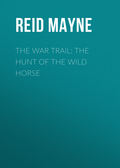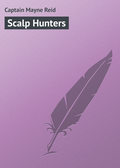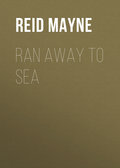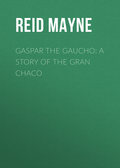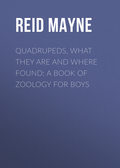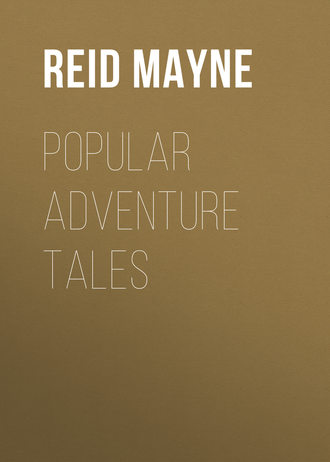
Майн Рид
Popular Adventure Tales
CHAPTER XXXV.
THE WILD ASSES OF AFRICA
Notwithstanding the success of the day's hunt, the mind of Von Bloom was not at rest. They had “bagged” their game, it was true, but in what manner? Their success was a mere accident, and gave them no earnest of what might be expected in the future. They might go long before finding another “sleeping-tree” of the elephants, and repeating their easy capture.
Such were the not very pleasant reflections of the field-cornet, on the evening after returning from their successful hunt.
But still less pleasant were they, two weeks later, at the retrospect of many an unsuccessful chase from which they had returned – when, after twelve days spent in “jaging” the elephant, they had added only a single pair of tusks to the collection, and these the tusks of a cow elephant, scarce two feet in length, and of little value!
The reflection was not the less painful, that nearly every day they had fallen in with elephants, and had obtained a shot or two at these animals. That did not mend the matter a bit. On the contrary, it taught the hunter how easily they could run away from him, as they invariably did. It taught him how small his chances were of capturing such game, so long as he could only follow it afoot.
The hunter on foot stands but a poor chance with the elephant. Stalking in upon one is easy enough, and perhaps obtaining a single shot; but when the animal trots off through the thick jungle, it is tedious work following him. He may go miles before halting, and even if the hunter should overtake him, it may be only to deliver a second shot, and see the game once more disappear into the bushes – perhaps to be spoored no farther.
Now the mounted hunter has this advantage. His horse can overtake the elephant; and it is a peculiarity of this animal, that the moment he finds that his enemy, whatever it be, can do that thing, he disdains to run any farther, but at once stands to bay; and the hunter may then deliver as many shots as he pleases.
Herein lies the great advantage of the hunter on horseback. Another advantage is the security the horse affords, enabling his rider to avoid the charges of the angry elephant.
No wonder Von Bloom sighed for a horse. No wonder he felt grieved at the want of this noble companion, that would have aided him so much in the chase.
He grieved all the more, now that he had become acquainted with the district, and had found it so full of elephants. Troops of an hundred had been seen; and these far from being shy, or disposed to make off after a shot or two. Perhaps they had never heard the report of a gun before that of his own long roer pealed in their huge ears.
With a horse the field-cornet believed he could have killed many, and obtained much valuable ivory. Without one, his chances of carrying out his design were poor indeed. His hopes were likely to end in disappointment.
He felt this keenly. The bright prospects he had so ardently indulged in, became clouded over; and fears for the future once more harassed him. He would only waste his time in this wilderness. His children would live without books, without education, without society. Were he to be suddenly called away, what would become of them? His pretty Gertrude would be no better off than a little savage – his sons would become not in sport, as he was wont to call them, but in reality a trio of “Bush-boys.”
Once more these thoughts filled the heart of the father with pain. Oh! what would he not have given at that moment for a pair of horses, of any sort whatever?
The field-cornet, while making these reflections, was seated in the great nwana-tree, upon the platform, that had been built on the side towards the lake, and from which a full view could be obtained of the water. From this point a fine view could also be obtained of the country which lay to the eastward of the lake. At some distance off it was wooded, but near the vley a grassy plain lay spread before the eye like a green meadow.
The eyes of the hunter were turned outward on this plain, and just then his glance fell upon a troop of animals crossing the open ground, and advancing towards the vley.
They were large animals – nearly of the shape and size of small horses – and travelling in single file; as they were, the troop at a distance presented something of the appearance of a “cafila,” or caravan. There were in all about fifty individuals in the line; and they marched along with a steady sober pace, as if under the guidance and direction of some wise leader. How very different from the capricious and eccentric movements of the gnoos!
Individually they bore some resemblance to these last-named animals. In the shape of their bodies and tails, in their general ground colour, and in the “brindled” or tiger-like stripes that could be perceived upon their cheeks, neck, and shoulders. These stripes were exactly of the same form as those upon a zebra; but far less distinct, and not extending to the body or limbs, as is the case with the true zebra. In general colour, and in some other respects, the animals reminded one of the ass; but their heads, necks, and the upper part of their bodies, were of darker hue, slightly tinged with reddish brown. In fact, the new-comers had points of resemblance to all four – horse, ass, gnoo, and zebra – and yet they were distinct from any. To the zebra they bore the greatest resemblance – for they were in reality a species of zebra – they were quaggas.
Modern naturalists have divided the Equidæ, or horse family, into two genera – the horse and the ass – the principal points of distinction being, that animals of the horse kind have long flowing manes, full tails, and warty callosities on both hind and fore limbs; while asses, on the contrary, have short, meagre, and upright manes, tails slender and furnished only with long hairs at the extremity, and their hind limbs wanting the callosities. These, however, are found on the fore-legs as upon horses.
Although there are many varieties of the horse genus – scores of them, widely differing from each other – they can all be easily recognised by these characteristic marks, from the “Suffolk Punch,” the great London drayhorse, down to his diminutive little cousin the “Shetland Pony.”
The varieties of the ass are nearly as numerous, though this fact is not generally known.
First, we have the common ass, the type of the genus; and of this there are many breeds in different countries, some nearly as elegant and as highly prized as horses. Next there is the “onagra,” “koulan,” or “wild ass,” supposed to be the origin of the common kind. This is a native of Asia, though it is also found in the north-eastern parts of Africa. There is also the “dziggetai,” or “great wild ass,” of Central and Southern Asia, and another smaller species the “ghur” found in Persia. Again, there is the “kiang” met with in Ladakh, and the “yo-totze,” an inhabitant of Chinese Tartary.
All these are Asiatic species, found in a wild state, and differing from one another in colour, size, form, and even in habits. Many of them are of elegant form, and swift as the swiftest horses.
In this little book we cannot afford room for a description of each, but must confine our remarks to what is more properly our subject – the wild asses of Africa. Of these there are six or seven kinds – perhaps more.
First, there is the “wild ass,” which, as already stated, extends from Asia into the north-eastern parts of Africa, contiguous to the former continent.
Next there is the “koomrah,” of which very little is known, except that it inhabits the forests of Northern Africa, and is solitary in its habits, unlike most of the other species. The koomrah has been described as a “wild horse,” but, most probably, it belongs to the genus asinus.
Now there are four other species of “wild asses” in Africa – wild horses some call them – and a fifth reported by travellers, but as yet undetermined. These species bear such a resemblance to one another in their form, the peculiar markings of their bodies, size, and general habits, that they may be classed together under the title of the zebra family. First, there is the true zebra, perhaps the most beautiful of all quadrupeds, and of which no description need be given. Second, the “dauw,” or “Burchell's zebra,” as it is more frequently called. Third, the “congo dauw,” closely resembling the dauw. Fourth, the “quagga”; and fifth, the undetermined species known as the “white zebra,” so called from its pale yellow, or Isabella colour.
These five species evidently have a close affinity with each other – all of them being more or less marked with the peculiar transversal bands or “stripes,” which are the well-known characteristics of the zebra. Even the quagga is so banded upon the head and upper parts of its body.
The zebra proper is “striped” from the tip of the nose to its very hoofs, and the bands are of a uniform black, while the ground colour is nearly white, or white tinged with a pale yellow. The “dauws,” on the other hand, are not banded upon the legs; the rays are not so dark or well defined, and the ground colour is not so pure or clean-looking. For the rest, all these three species are much alike; and it is more than probable that either “Burchell's” or the “congo dauw” was the species to which the name of “zebra” was first applied; for that which is now called the “true zebra” inhabits those parts of Africa where it was less likely to have been the first observed of the genus. At all events, the “congo dauw” is the “hippotigris,” or tiger-horse, of the Romans; and this we infer from its inhabiting a more northerly part of Africa than the others, all of which belong to the southern half of that continent. The habitat of the zebra is said to extend as far north as Abyssinia; but, perhaps, the “congo dauw,” which certainly inhabits Abyssinia, has been mistaken for the true zebra.
Of the four species in South Africa, the zebra is a mountain animal, and dwells among the cliffs, while the dauw and quagga rove over the plains and wild karoo deserts. In similar situations to these has the “white zebra” been observed – though only by the traveller Le Vaillant – and hence the doubt about its existence as a distinct species.
None of the kinds associate together, though each herds with other animals! The quagga keeps company with the gnoo, the “dauw” with the “brindled gnoo,” while the tall ostrich stalks in the midst of the herds of both!
There is much difference in the nature and disposition of the different species. The mountain zebra is very shy and wild; the dauw is almost untameable; while the quagga is of a timid docile nature, and may be trained to harness with as much facility as a horse.
The reason why this has not been done, is simply because the farmers of South Africa have horses in plenty, and do not stand in need of the quagga, either for saddle or harness.
But though Von Bloom the farmer had never thought of “breaking in” a quagga, Von Bloom the hunter now did.
CHAPTER XXXVI.
PLANNING THE CAPTURE OF THE QUAGGAS
Up to this time the field-cornet had scarce deigned to notice the quaggas. He knew what they were, and had often seen a drove of them – perhaps the same one – approach the vley and drink. Neither he nor any of his people had molested them, though they might have killed many. They knew that the yellow oily flesh of these animals was not fit for food, and is only eaten by the hungry natives – that their hides, although sometimes used for grain-sacks and other common purposes, are of very little value. For these reasons, they had suffered them to come and go quietly. They did not wish to waste powder and lead upon them; neither did they desire wantonly to destroy such harmless creatures.
Every evening, therefore, the quaggas had drunk at the vley and gone off again, without exciting the slightest interest.
Not so upon this occasion. A grand design now occupied the mind of Von Bloom. The troop of quaggas became suddenly invested with as much interest as if it had been a herd of elephants; and the field-cornet had started to his feet, and stood gazing upon them – his eyes sparkling with pleasure and admiration.
He admired their prettily-striped heads, their plump well-turned bodies, their light elegant limbs; in short, he admired everything about them, size, colour, and proportions. Never before had quaggas appeared so beautiful in the eyes of the vee-boer.
But why this new-born admiration for the despised quaggas? – for despised they are by the Cape farmer, who shoots them only to feed his Hottentot servants. Why had they so suddenly become such favourites with the field-cornet? That you will understand by knowing the reflections that were just then passing through his mind.
They were as follows: —
Might not a number of these animals be caught and broken in? – Why not? Might they not be trained to the saddle? – Why not? Might they not serve him for hunting the elephant just as well as horses? – Why not?
Von Bloom asked these three questions of himself. Half a minute served to answer them all in the affirmative. There was neither impossibility nor improbability in any of the three propositions. It was clear that the thing could be done, and without difficulty.
A new hope sprang up in the heart of the field-cornet. Once more his countenance became radiant with joy.
He communicated his thoughts both to the Bushman and “Bush-boys” – all of whom highly approved of the idea, and only wondered that none of them had thought of it before.
And now the question arose as to how the quaggas were to be captured. This was the first point to be settled; and the four – Von Bloom himself, Hans, Hendrik, and Swartboy, – sat deliberately down to concoct some plan of effecting this object.
Of course they could do nothing just then, and the drove that had come to drink was allowed to depart peacefully. The hunters knew they would return on the morrow about the same hour; and it was towards their return that the thoughts of all were bent.
Hendrik advised “creasing,” which means sending a bullet through the upper part of the neck near the withers, and by this means a quagga can be knocked over and captured. The shot, if properly directed, does not kill the animal. It soon recovers, and may be easily “broken,” though its spirit is generally broken at the same time. It is never “itself again.” Hendrik understood the mode of “creasing.” He had seen it practised by the boer-hunters. He knew the spot where the bullet should hit. He believed he could do it easily enough.
Hans considered the “creasing” too cruel a mode. They might kill many quaggas before obtaining one that was hit in the proper place. Besides there would be a waste of powder and bullets – a thing to be considered. Why could they not snare the animals? He had heard of nooses being set for animals as large as the quaggas, and of many being caught in that manner.
Hendrik did not think the idea of snaring a good one. They might get one in that way – the foremost of the drove; but all the others, seeing the leader caught, would gallop off and return no more to the vley; and where would they set their snare for a second? It might be a long time before they should find another watering-place of these animals; whereas they might stalk and crease them upon the plains at any time.
Swartboy now put in his plan. It was the pit-fall. That was the way by which Bushmen most generally caught large animals, and Swartboy perfectly understood how to construct a pit for quaggas.
Hendrik saw objections to this, very similar to those he had urged against the snare. The foremost of the quaggas might be caught, but the others would not be fools enough to walk into the pit – after their leader had fallen in and laid the trap open. They, of course, would gallop off, and never come back that way again.
If it could be done at night, Hendrik admitted, the thing might be different. In the darkness several might rush in before catching the alarm. But no – the quaggas had always come to drink in day-time – one only could be trapped, and then the others alarmed would keep away.
There would have been reason in what Hendrik said, but for a remarkable fact which the field-cornet himself had observed when the quaggas came to the lake to drink. It was that the animals had invariably entered the water at one point, and gone out at another. It was of course a mere accident that they did so, and owing to the nature of the ground; but such was the case, and Von Bloom had observed it on several occasions. They were accustomed to enter by the gorge, already described; and, after drinking, wade along the shallow edge for some yards, and then pass out by another break in the bank.
The knowledge of this fact was of the utmost importance, and all saw that at once. A pit-fall dug upon the path by which the animals entered the lake, would no doubt operate as Hendrik said – one might be caught, and all the rest frightened off. But a similar trap placed upon the trail that led outward, would bring about a very different result. Once the quaggas had finished drinking, and just at the moment they were heading out of the water, the hunters could show themselves upon the opposite side, set the troop in quick motion, and gallop them into the trap. By this means not only one, but a whole pit-full might be captured at once!
All this appeared so feasible that not another suggestion was offered – the plan of the pit-fall was at once, and unanimously adopted.
It remained only to dig the pit, cover it properly, and then wait the result.
During all the time their capture was being planned, the herd of quaggas had remained in sight, disporting themselves upon the open plain. It was a tantalizing sight to Hendrik, who would have liked much to have shown his marksman skill by “creasing” one. But the young hunter saw that it would be imprudent to fire at them there, as it would prevent them from returning to the vley; so he restrained himself, and along with the others remained watching the quaggas – all regarding them with a degree of interest which they had never before felt in looking at a drove of these animals.
The quaggas saw nothing of them, although quite near to the great nwana-tree. They – the hunters – were up among the branches, where the animals did not think of looking, and there was nothing around the bottom of the tree to cause them alarm. The wagon-wheels had long ago been disposed of in the bush, partly to shelter them from the sun, and partly because game animals frequently came within shot of the tree, and were thus obtained without any trouble. There were scarce any traces upon the ground that would have betrayed the existence of a “camp” in the tree; and a person might have passed very near without noticing the odd aërial dwelling of the hunter family.
All this was design upon the part of the field-cornet. As yet he knew little of the country around. He did not know but that it might contain worse enemies than either hyenas or lions.
While they sat watching the manœuvres of the quaggas, a movement was made by one of these creatures more singular than any that had yet been witnessed.
The animal in question was browsing quietly along, and at length approached a small clump of bushes that stood out in the open ground. When close to the copse it was observed to make a sudden spring forward; and almost at the same instant, a shaggy creature leaped out of the bushes, and ran off. This last was no other than the ugly “striped” hyena. Instead of turning upon the quagga and showing fight, as one might have supposed so strong and fierce a brute would have done, the hyena uttered a howl of alarm, and ran off as fast as its legs would carry it.
They did not carry it far. It was evidently making for a larger tract of bush that grew near; but before it had got half-way across the open ground, the quagga came up behind, and uttering his shrill “couaag,” reared forward, and dropped with his fore-hoofs upon the hyena's back. At the same instant the neck of the carnivorous animal was clutched by the teeth of the ruminant and held as fast, as if grasped by a vice.
All looked to see the hyena free itself and run off again. They looked in vain. It never ran another yard. It never came alive out of the clutch of those terrible teeth.
The quagga still held his struggling victim with firm hold – trampling it with his hoofs, and shaking it in his strong jaws, until in a few minutes the screams of the hyena ceased, and his mangled carcass lay motionless upon the plain!
One would think that this incident might have been enough to warn our hunters to be cautious in their dealings with the quagga. Such a sharp biter would be no pleasant horse to “bit and bridle.”
But all knew the antipathy that exists between the wild horse and the hyena; and that the quagga, though roused to fury at the sight of one of these animals, is very different in its behaviour towards man. So strong, in fact, is this antipathy, and so complete is the mastery of the ruminant over the carnivorous animal, that the frontier farmers often take advantage of these peculiar facts, and keep the hyenas from their cattle by bringing up with the herd a number of quaggas, who act as its guards and protectors!



